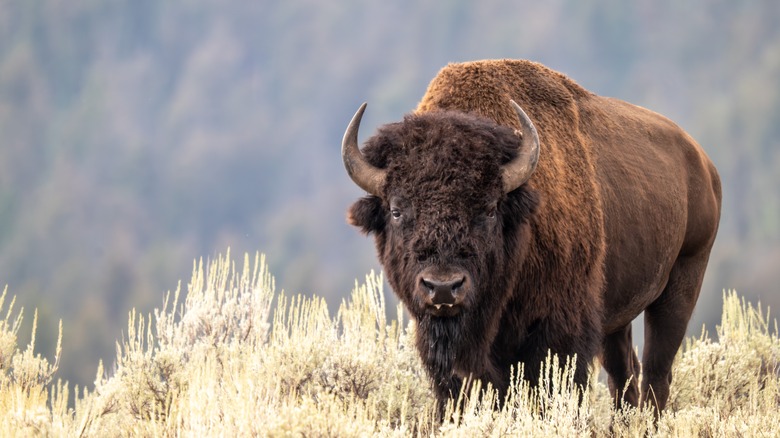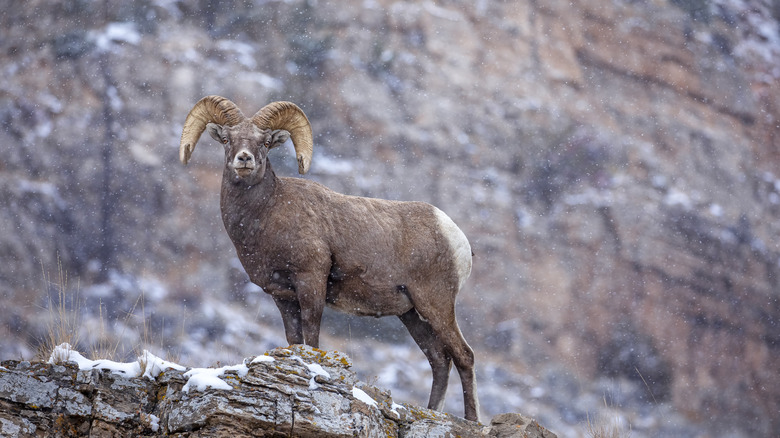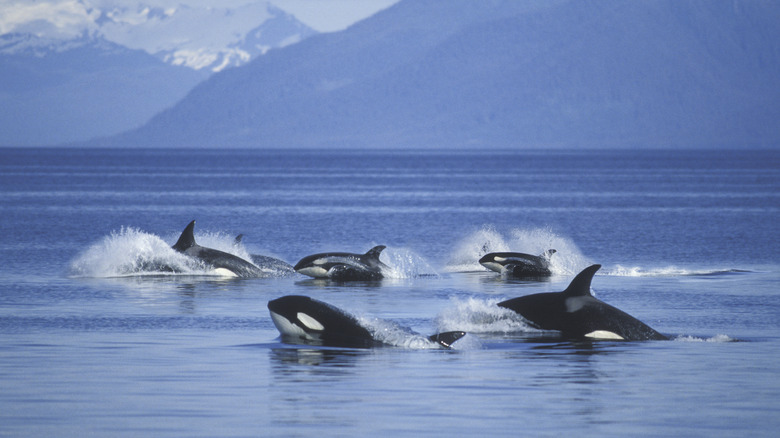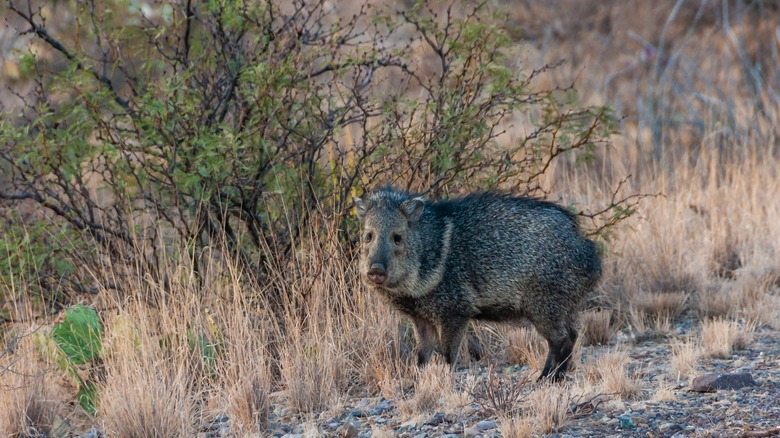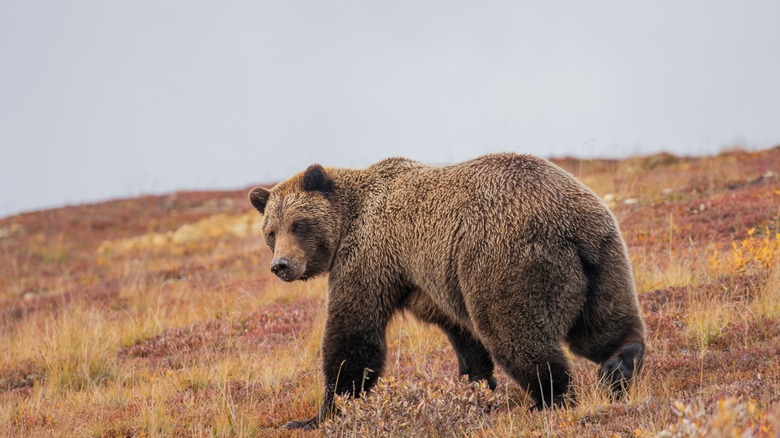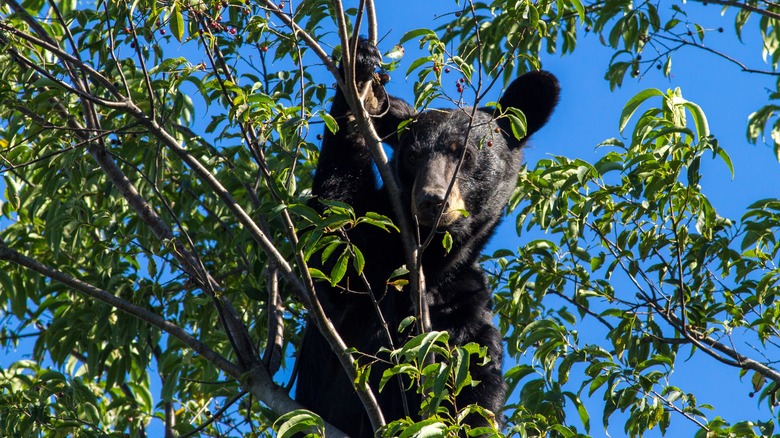The Best US National Parks To Visit If You Love Watching Wildlife
There are many reasons to visit America's National Parks. From camping near iconic landmarks to hiking some of the most photogenic natural landscapes in the entire world, to kayaking or canoeing a body of water, a trip to one of the country's 63 National Parks should be on the bucket list of all outdoor enthusiasts. For all the natural splendor, however, there is yet another reason why tens of millions of people visit the National Parks every year: wildlife.
It can sometimes be lost on visitors that the conservation efforts that resulted in the establishment of the National Parks weren't simply aimed to maintain the stunning landscapes. The conservation also extends to the parks' native wildlife. Some of America's most recognizable species, such as bison, elk, moose, and grizzly bears, call the National Parks their homes.
But, where can you get the most bang for your buck in terms of wildlife watching? Realize that not all of the Parks are created equal in this regard. They all have wildlife, but only a few are truly astounding in terms of variety and quantity of species. So, based on our research, we present to you the best US National Parks to visit if you love watching wildlife.
Megafauna at Yellowstone
It should come as no surprise that the most iconic National Park of them all would be the best for wildlife viewing. Yellowstone National Park is a veritable sanctuary. Home to over 60 different species of mammals – you'll be hard-pressed not to catch a glimpse of some of the most recognizable species on the continent. This includes megafauna like bison, bighorn sheep, and elk as well as osprey, bald eagles, mountain goats, and mule deer.
Your success in wildlife watching depends mostly on timing. In general, mornings and early evenings during feeding are the best times to spot wildlife. As far as time of year, September, October, and April are great for milder weather, and fewer crowds. Thanks to Yellowstone's intensely cold and snowy winters, catching sight of animals during the coldest months is minimal unless you're prepared with the proper equipment like skis, snowshoes, or a snowmobile (with a permit, of course).
The Park advises that wildlife watchers keep their distance from the animals, many of which are considered highly dangerous. According to the National Park Service, the minimum viewing distance for the majority of the animals is 25 yards, increasing to 100 yards for more aggressive animals like grizzly bears and gray wolves. Still, the likelihood you'll even need to exit your vehicle to catch a glimpse of these magnificent animals is rather low, which is why Yellowstone is the best park in the system to catch sight of wildlife.
Grand Teton is the best place to catch glimpses of moose
Personal aside before we begin: There are some people — i.e. my wife — who believe that moose are mythical creatures. No matter how much evidence exists, she insists that they do not exist. It could be because she's the only member of our family who has yet to see a moose, but that's beside the point. There is some truth to her assertion, however. Moose are one of the most elusive animals in North America. Despite being enormous, moose can disappear in the blink of an eye, which is why they are so difficult to find. That is, of course, unless you visit Grand Teton National Park.
While there are many states that boast a reputation for moose, you can only be sure of seeing one if you spend some time in Grand Teton. While there are plenty of other species of megafauna in the park, including elk, wolves, and bison, moose seem to have a particular fondness for the Park and are relatively easy to spot throughout the 310,000 acres.
Still, you have to know where in the Park to go. The Rustic Inn at Jackson Hole suggests that Oxbow Bend and Moose-Wilson Road are the best spots to see moose grazing. Free Roaming Photography also recommends Swashbuckler Landing. As was the case in Yellowstone, keep a good distance. Moose, especially bull moose, will charge when threatened. And, trust me, you don't want to be on the receiving end of that.
Lake Clark is teeming with brown bears
Alaska is considered by many to be the last wilderness frontier in the United States. This truth is typified by Lake Clark National Park And Preserve. One of the most remote National Parks, Lake Clark is Alaska wilderness on steroids. Not far from Anchorage, it sits at a junction between ocean and mountains. Not only does this make it a place of unparalleled natural beauty, but also a great place for watching native brown bears.
Coastal brown bear populations thrive in this area of Alaska. Thanks to several estuaries that are filled with seasonal runs of salmon, bears congregate in the preserve to eat, mate, and put on a show for visitors. There is hardly a spot in the Park where you won't find brown bears. A great way to view them is by boat. This way you have a good distance between you and them, while also getting a unique opportunity of watching them feed. Excellent spots for this are Chinitna Bay and Silver Salmon Creek.
Eagles are another animal to watch for at Lake Clark. Thanks again to the large number of salmon inhabiting the park, it is common to see bald or golden eagles diving into a stream or lake and emerging with a fish writhing in their talons. It's an amazing slice of pure, unfiltered Alaska wilderness.
See the best of Montana at Glacier National Park
For those of us who have watched "A River Runs Through It" an excessive number of times, Montana holds a unique place in our hearts. The film goes above and beyond to capture the rich natural beauty of the state and is responsible for increased numbers of tourists to towns and rivers throughout the state. And for those who want the best scenery Montana has to offer, as well as to see some outstanding wildlife, a trip to Glacier National Park is a must.
The Rocky Mountains are what make for such a diverse crew of animals who call Glacier their home. Notable among the Park's mammals are moose, elk, bear, lynx, and mountain lions. Even smaller, more secretive animals like pikas, pygmy shews, beavers, and bats can be found if a keen watcher is looking hard enough. However, it's the Rocky Mountain bighorn sheep that really put on a show.
These massive bovines are famous for their amazing displays of strength. Between October and January, mating season forces ram bighorns to fight for mates and dominance over a herd. To do this, they run full speed at each other and ram their heads together. If you time your visit right, you might just see these amazing creatures in action. And thanks to its size, Glacier is the best place for it.
Mountains meet the sea at Olympic National Park
The northwestern coast of the United States is home to some of the most biologically diverse wildlife in the entire country. Nowhere is this more evident than at Olympic National Park in Washington. Set on the eponymous peninsula, Olympic National Park is a natural wonder. One of the best National Parks for freshwater fishing, mountains and streams meet the shore and sea in a brilliant display of evergreen forest and rocky coastline. This provides visitors with the best of both worlds as far as wildlife viewing is concerned, according to reviews from TripAdvisor.
One of the fascinating things about wildlife at Olympic is that several species are endemic to the park. This means that you cannot find them anywhere else. As such, Olympic National Park is the only place in the world where you can see Olympic snow moles, Olympic marmots, and torrent salamanders.
The joining of sea and earth provides excellent opportunities to view both land and marine life. In one day you can go from spying pods of orcas off the coast, to looking upwards for barred owls in the trees. And don't forget the numerous elk, bears, eagles, and moose that just prove how much of an amazing natural wonder this spot is. Just remember, as elsewhere, to be wary of these animals. Never feed or approach them, and definitely don't try to touch them.
The Everglades is home to over 300 species of birds
Birdwatchers rejoice! While the sheer amount of American bird species can seem absolutely staggering, those hoping to catch a good amount of species in a single area would do well to venture to Everglades National Park. Many birders engage in an annual Big Year, an informal in which they compete to see who can spot over 700 species in a calendar year. What makes the Everglades is that it is home to over 300 species of birds.
Hidden among the reeds, swamps, and razor-sharp grasses of Everglades National Park are hundreds upon hundreds of birds. Wading birds like white egrets, ibis, great blue herons, and flamingos live alongside cormorants, barred owls, and frigate birds. The vibrant colors on some of these birds make them particularly photo-worthy. Even if you aren't a birdwatcher, you can't deny the pleasure of seeing hundreds of colorful birds take flight in a single setting.
And, of course, we can't leave out the alligators and crocodiles. Florida is the only place in the world where you can see both. Everywhere you look in the Everglades there is a chance you will see eyes looking at you from out of the water. As unsettling as this sounds, the sight of a fully grown alligator or crocodile is something to behold. While you want to be cautious of these creatures at all times, there's nowhere better than the Everglades for seeing them close-up.
Make it to Elktober at Rocky Mountain National Park
As mentioned earlier, the Rocky Mountains are home to a truly astounding variety of animals. Stretching from Canada all the way down to New Mexico, these mountains form the spine of the western United States. Yet, there is no state more associated with these mountains than Colorado. And it is here, at Rocky Mountain National Park, that wildlife enthusiasts can come to see one of the most astounding occurrences in the natural world.
Known colloquially as "Elktober", this time of year in mid-autumn is when thousands of bull elk descend upon the park to find their mates. It is not unusual for them to be blocking traffic on the roadways, shutting down trails, or making their way through unattended coolers at the campsite. The bulls are in search of mates, which means that plenty of drama is about to ensue.
Elks will bugle loudly and lock antlers to try and overpower one another and win the approval of a mate. While it might not be as dramatic as the bighorn sheep, the elk still put on a good show. Just be sure, as always to keep your distance, and don't venture into mating areas that have been blocked off in the Park.
Wild horses at Theodore Roosevelt National Park
Theodore Roosevelt National Park is one of the lesser known of the parks, but is no less beautiful as a result. Named for the "Father of the National Parks System", this 70,000 acre park is set in the heartland of North Dakota. There are many species to be found here in the park, but we're going to focus our attention on one in particular: horses.
Very fitting of the 26th U.S. President, the park is home to hundreds of nationally protected wild horses. It is one of the few places in the country where you can come and see horses that are totally untamed and free. Seeing a herd gallop across the plains is enough to bring tears to anyone's eyes.
Unlike Assateague Island in Maryland, where the horses come into regular contact with visitors, the horses of Theodore Roosevelt National Park should not be approached. Remember, they are wild and live their lives foraging the landscape. They are not used to people and, like all horses, can very easily be spooked. So, make sure you keep your admiration at a distance and invest in a good pair of binoculars to see them close up.
Amazing tropical sea life at US Virgin Islands National Park
Nestled deep in the Caribbean Sea, the U.S. Virgin Islands are an amazing place to enjoy a tropical vacation without leaving the United States. Filled with sandy, sun-drenched beaches, vacationers will have no trouble relaxing in this idyllic location. Much of the pristine jungle and coastline is protected as part of the U.S. Virgin Islands National Park, perhaps the best marine National Park in the system. This designation makes Virgin Islands National Park the perfect place to venture out and observe some amazing sea life up-close!
There are several guided trips out of places like Trunk Bay and Cinnamon Bay that will bring you out into the crystal clear waters of the Park. On a snorkeling adventure, you can see the amazing life teeming below the surface. Sea turtles, sharks, hundreds of species of vibrantly-colored tropical fish, and coral reefs combine for a truly spectacular underwater experience.
If snorkeling isn't your cup of tea, fear not. There are plenty of other creatures, including bats, birds, goats, sheep, and donkeys, that are sure to tickle your wildlife-watching fancy. However, the most abundant life you will see is out in the ocean. Just be sure to follow the guidelines we've repeated throughout this list. Keep a good distance away from the animals, and follow all safety precautions when snorkeling, and you should have a truly wonderful experience.
Big Bend is more than just desert landscape
The desert landscape of south Texas may not seem like the most hospitable place on the planet. Indeed, with daytime temperatures reaching in excess of 100 degrees Fahrenheit, Big Bend National Park is one of the most dangerous National Parks you can visit. Dehydration and heat stroke are things to take into consideration when exploring this beautiful place. However, don't think that just because it's hot out that you won't see your fair share of wildlife.
There are actually a wide variety of wildlife living within the borders of Big Bend. Mammals like hares, collared peccary hogs, bobcats, and coyotes, birds like roadrunners, and plenty of reptiles (many of which you need to be cautious of) can all be found around the Park. Thanks to its proximity to the Rio Grande River, several species of amphibians call Big Bend home, making it a more biologically diverse desert landscape.
Owing to the harsh environment in which they live, most of these animals cannot be seen during daylight hours. The best time to see wildlife is during the cooler hours of dawn and dusk. The lower temperatures and light make it easier for them to leave their hollows and hunt for food.
Whales and bears at Glacier Bay National Park
Not to be confused with Glacier National Park in Montana, Glacier Bay National Park and Preserve in Alaska is just further proof of the state's status as a natural wonder. Set at the northern tip of the state's southern string of islands and peninsulas, Glacier Bay is yet another example of mountains meeting the sea, and is highly recommended as a place to see all sorts of wildlife, via TripAdvisor.
The type of wildlife you see depends in large part on where you are in the Park. However, the coastal areas are going to be your best bet to see the most wildlife. Seals, salmon, grizzly bears, and brown bears are incredibly easy to spot along the coast, especially if you are viewing them from a boat. Glacier Bay Country Inn offers boat tours to Chichagof Island, a known location where visitors can see these famous bears up-close. Yet, you need to go a little farther out to sea to witness one of the most amazing natural displays in the world.
Whale watching is peak wildlife viewing here. Humpback whales arc majestically through the water. Orcas and minke whales bob up and down with the current. Bald eagles soar overhead. It's an amazing thing to see. Whale-watching tours operate out of Gustavus, Alaska, and take tourists out into the Icy Straits near the bay to see this amazing display of wildlife.
Shenandoah National Park has wildlife all year
There are few places with mild enough temperatures to allow for year-round wildlife viewing. Shenandoah National Park is one of those rare places where temperatures never get too hot or too cold to force all of the animals in the park to go into hiding. Some do, don't get us wrong, but what makes Shenandoah so special is the sheer amount of animals you can see throughout the year.
While it is not home to particularly rare megafauna or whales, Shenandoah has dozens of species that wildlife watchers can see all year long. These include coyotes, whitetail deer, beavers, owls, and black bears. Plus, fishermen can enjoy the over 40 species of fish found in the Park's rivers and ponds, which don't tend to ice over during the winter months.
No matter what park you visit, you are more than likely going to experience some wildlife. It's part of the overall experience. However, nothing beats the sheer range and diversity of the wildlife you can see at these 12 amazing National Parks. So get out there and explore!
Methodology
These recommendations come to you based on several sources, including experiences and reviews from travel bloggers and visitors who have explored these National Parks. We have confirmed these accounts by cross-referencing them with official government websites, trusted travel sources, area news networks, and local businesses in order to provide you with the most accurate, safe, and up-to-date travel advice.

